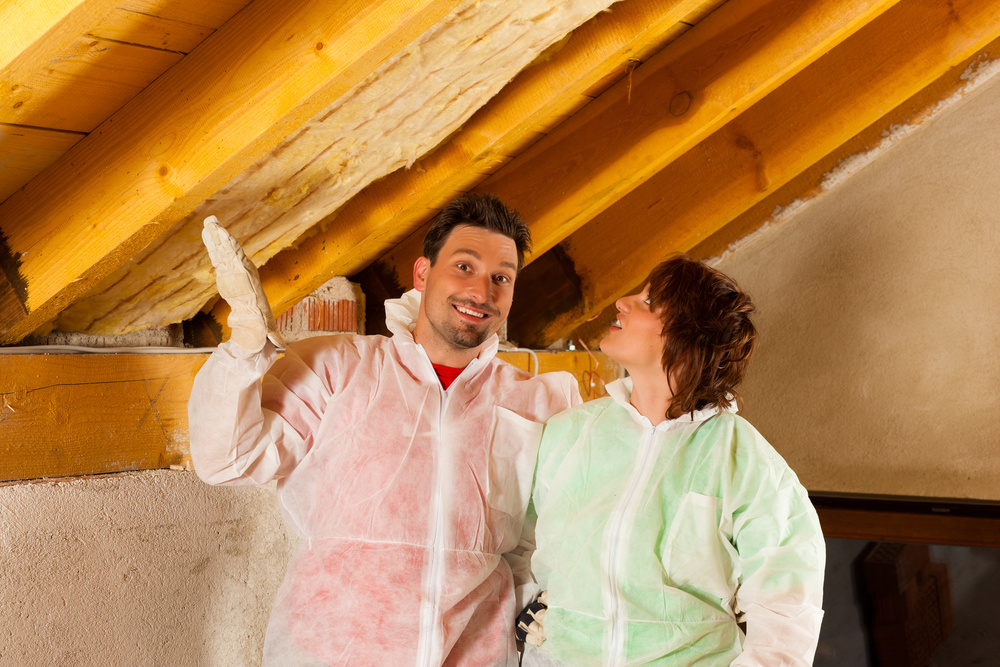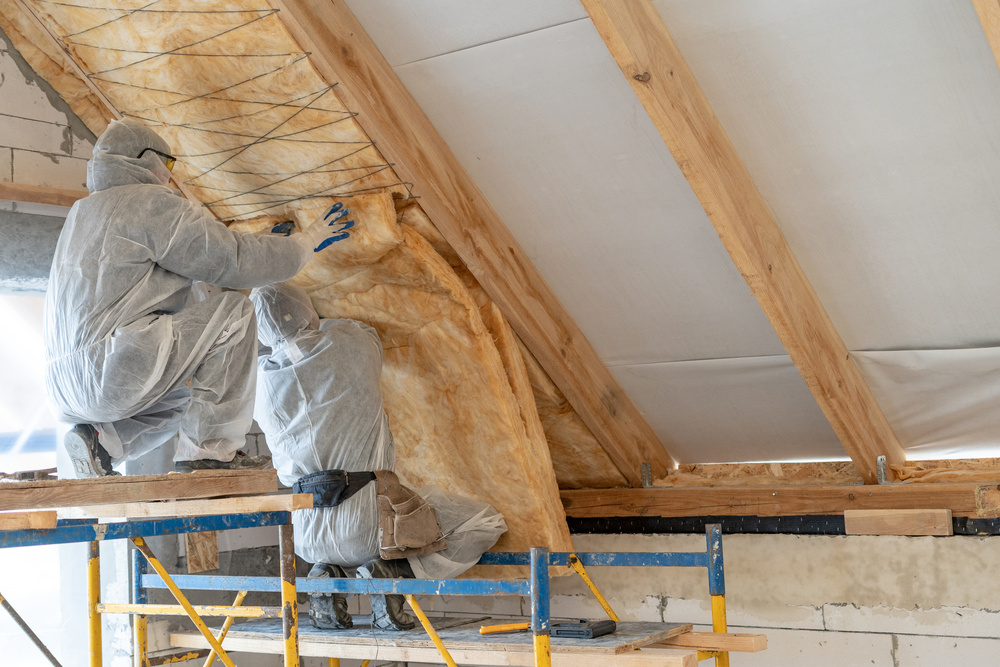Table of Contents Show
One way to keep your home warm and comfortable during the cold season is by ensuring your roof is properly insulated. Additionally, you can reduce the cost of heating your home by ensuring that the roof insulation is well done.
So, if you’re planning to install roof insulation in your home, it’s a good idea to have some basic knowledge and understanding about quality materials that are long-lasting and effective.

You can start by researching materials, prices, brands, and the best way to install roof insulation. If you’re unsure which materials to use, you can shop around and compare the quality and prices of different brands.
If you’re new to roof insulation installation, here’s a guide to making the process easier:
The Best R-Value for Roof Insulation
You must consider the R-value before purchasing insulation materials for your roof. Ideally, the higher the R-value of the insulating material, the higher the thermal resistance.
It means that if the insulation material has a high R-value, it’ll be efficient at slowing heat transfer. You can also research more information regarding insulation materials with a good R-value.
In addition, you must consider an R-value that’s appropriate for where you’re located. For instance, if you live in a warm area, it’d be best to get insulation with a minimum R-value of 4.0.
On the other hand, if you live in a cold environment, it’d be best to get insulation with an R-value of 5.0 and above.
Read Also:
Types Of Insulation Materials
Many types of insulation materials are available on the market, and you must carefully consider your needs before buying one. The difference in the material types is in the price and the R-value.
So, you must consider the weather and climate patterns in your area and the architectural design of your home to determine the most appropriate R-value for the insulation materials in your home. The following insulation materials are available on the market:
1. Spray Foam Insulation
The most common type of roof insulation you might consider is spray foam insulation. The downside of spray foam insulation is that it must be installed by a professional because of adhering to corners and joists.
A professional will also ensure that the corners are installed in a way that requires no need for a vapor barrier, thus ensuring that the home is sufficiently protected from temperature changes. The spray foam insulation comes in the following types:
- Closed-cell: This spray foam insulation has a high-density structure, is more rigid, and has a higher R-value, making it suitable for cold areas.
- Open-cell: This spray cell insulation material is less dense and has a lower R-value, which makes it more appropriate for warmer areas.
Your contractor should help you choose the best spray foam insulation type for your home. So, it shouldn’t be a taxing task for you.
2. Foam Board Insulation
One of the reasons that you might prefer this insulation material is because it provides a high R-value for its thickness compared to other materials. The material is made from polyurethane or polyisocyanurate, which makes it great for insulation.
However, you must ensure that the material is coated with gypsum sheathing or any other fire-resistant material to meet building code standards and regulations.
Additionally, this material option is perfect if you’re planning a DIY project because it’s easy to install because of its rigidity, and you can cut it while fitting it into spaces. The material is also cost-effective and can easily fit into your budget.
Another interesting fact about this material is that its R-value ranges from 3.6 to 5.8, making it suitable for cold and warm areas.
Some benefits of foam board insulation are that they prevent moisture accumulation, airflow, and air leaks into your home because they can be cut to fit into spaces.
If your home has structural gaps, you can use this material as a secondary barrier, closing off areas that might allow air leaks.
3. Reflective Insulation
Another material you can consider is reflective insulation, which is a thin tin-foil-like layer. This material is appropriate for people living in a hot environment because it reflects heat outward during the hot seasons and inward during the cold seasons.
The materials are also perfect for a DIY project because of their flexibility, which makes them easy to work with.
In addition, the material is an excellent option for you because of its cost-effectiveness.
When buying the reflective insulation, you’ll have to get large rolls that are either 24 or 48 inches in width, and the price can be lower if you buy in bulk. The material is also waterproof and non-toxic, which significantly benefits roof insulation.
On the flip side, the material has a low R-value of about 1.0, which might not be effective in cold areas. It means that the material can’t be used solely for roof insulation but can be used as a supplement layer for hard foam insulation.
Basic Fun Facts You Should Know
Understanding what insulation is and its benefits to your home are essential to your installation journey. As mentioned earlier, it’s crucial to have basic knowledge of roof insulation to have an easy time during installation.
Here are a few fun facts that might be helpful in your roof insulation installation:
- Insulation maintains temperature around the home: The purpose of insulating a home is to provide heat resistance to reduce heat flow, therefore, maintaining the temperature created by the heating system.
- Insulation doesn’t block air circulation or ventilation around your home. While your home can still get air circulation, the insulation ensures that the warm air is kept in and the cold air stays outside.
- Insulation makes a home energy efficient by controlling the temperature in your home. A home that has inadequate insulation uses more energy to maintain the temperature of heat getting lost.
- Proper home insulation helps save money because less energy is used to heat and cool the house. Hence, you can use the money saved on energy costs to spend on other areas around the home.
- The weather and climate of your home are crucial in determining the material to use and the sufficient size. Warm areas have insulation needs that differ from cold areas, and the R-value of the materials used is different.
- The type of heating, whether electricity, gas, or oil, you use in your property also plays a role in determining the most favorable insulating material for your home.
- You can consider insulation an investment because of the money it’ll save you in energy consumption costs.
- Roof insulation provides bonus benefits for your home, such as sound and moisture control.
If you want to enjoy these benefits, head on over to your nearest hardware store and purchase insulation materials for your home. On top of the many utility benefits it brings to your home, they also keep your life comfortable.
Choosing Roof Insulation
When choosing a roofing insulation material for your home, you must consider the following:
- The size of the roof and how much insulation would be adequate.
- Your budget and how much you’re willing to spend on the insulation materials and the installation process.
- Your accessibility to the roof and the equipment you’ll need to reach it when working.
- Availability of insulation materials and whether you’ll be buying them locally or if it has to be shipped.
- Whether you’ll be hiring a professional or it’s a DIY project.
It’d be helpful to make a checklist of the considerations when buying roof insulation. That way, your buying journey will be stress-free.
Best Roof Insulation Material
Considering the different types of roof insulation on the market, spray foam insulation might be the best option. During installation, the material provides adequate coverage, and its air-sealing capacity ensures that corners and spaces are sealed.
While the process might be costly because you’ll have to hire a professional to ensure that the application is done correctly, its efficacy will be worth it.
To DIY Or Hire a Professional
Hiring a professional insulation installer or making the installation a DIY project might not entirely be up to you, and you must consider other factors. The material you opt to use will determine whether or not you’ll need a professional to install the roof insulation.
For instance, if you opt for spray foam insulation, you must hire a professional because they’re technical. On the other hand, if you’re using foam board insulation, you don’t need to hire a professional for installation.
Installing New Insulation Over Old Insulation
If your home already has roof insulation that might be starting to get worn out, there’s no need to get rid of all of it and start afresh. You can consider layering the old insulation with new insulation materials.
While layering the insulation materials, your goal is to improve the R-value, and you can go for materials with a higher rate.
However, you must ensure that you’ve thoroughly inspected the old roof insulation for mold or infestations before adding a layer of new insulation. If the old insulation is damaged to the extent that it isn’t effective anymore, it should be removed entirely to pave the way for new insulation.
Roof Insulation Installation Process
If you’ve opted to install the roof insulation yourself, consider the following steps:
1. Purchase The Materials
It’d help if you were adequately prepared physically, mentally, and financially before installing your roof insulation. One thing you must do when preparing is ascertaining that you’ve bought the right type, size, and amount of insulating materials for your roof.
You can inquire from a professional about the amount, size, and type of materials by providing measurements and the type of heating you’ll use in the home.
2. Get The Right Tools And Equipment
You must also collect all the tools and equipment required for installing the roof insulation. There’s no need to purchase the equipment if you rent some tools such as ladders and cutting tools such as knives and scissors.
You’ll also need protective gear such as safety glasses, dust masks, and gloves. You can get these tools and equipment from your local retailer or purchase them online.
3. Install The Insulation Batts
Preloading the batts into the ceiling spaces is best to make the installation quicker and easier. Ensure you go in straight lines to avoid going back and forth during the installation process. Your goal should be an even height and a snug fit when preloading the batts.
As you work, trim the excess insulation panels to ensure a perfect fit. The cut-offs that you’ve trimmed can be used to fill gaps and spaces.
In addition, you must be careful to ensure that you have enough space left for ventilation, downlights, and piping. Blocking ventilation spaces can be detrimental to you and your family because of insufficient airflow.
Conclusion
Roof insulation is vital in a home and should be installed appropriately for efficiency and efficacy. While there are many roof insulation materials in the market, you must choose one that suits your needs and is appropriate for your home.
Always ensure that you’ve considered the R-value of the insulation material before purchasing it to ascertain efficiency. If you experience challenges during installation, consult a professional to ensure that the roof insulation is fixed correctly.










